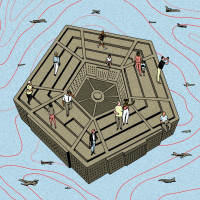Digital capitalism is a mine not a cloud Exploring the extractivism at the root of the data economy
Topics
Big Tech seeks through abstractions of the ‘cloud’ to hide the depletion of nature and the exploitation and surveillance of labour that lies at the heart of its project to commodify data.

Illustration by Anđela Janković
Berlin’s largest data centre is located in a faceless, grey building, between a tax office, two used car dealers and a building materials store in the Siemensstadt neighbourhood. It meets its high energy demand from the Reuter West coal-fired power plant, which supplies electricity to one million households in Berlin and is not far from the data centre. From the outside, it looks nothing like the Big Tech portrayal of the cloud as an airy unreal digital space. Inside the building are countless stacks of servers, humming away and consuming large amounts of fossil-fuelled electricity and water in order to enable massive streams of data to circulate.
It seems unlikely that this place, operated by the Japanese telecommunications company NTT, might have any connection to the history of the neighbourhood, which was built by the industrial giant Siemens for its production and for housing its workers over 120 years ago. And yet, this building and the infrastructure it represents makes possible the world’s wealthiest and most powerful companies. It is a manifestation of the exploitation of people and the extractivism that is ravaging the planet and that increasingly attempts to colonise our lives and social relations in the form of data.
Big Tech companies, such as Alphabet, Amazon, Apple, Microsoft or Meta, as well as their Chinese versions such as Alibaba, Tencent and Weibo, like to claim that data is a new ‘raw’ material that is there for taking. A reservoir that waits to be discovered by capable actors, who will tap into it and release data’s potential for the benefit of humankind. The latest spin of Google’s chief financial officer, for example, was to abandon the metaphor of data as the new oil in favour of likening it to sunlight, implying that data is a ‘replenishable, inexhaustible (especially as compared to finite oil) and owner-less resource that can be harvested sustainably’
This narrative naturalises and conceals the pervasive infrastructures that are built in order to generate data, and the corporate aspiration to transform potentially all human experience and social interaction into data to be extracted. This would not only violate our privacy, leaving us with no means to give any meaningful consent, but – as data is always relational – conscripts us to relations in which we participate in the oppression of one another.
This narrative also hides the actors that appropriate, aggregate and sell this data for economic profit and, thus, their underlying choices about which data is worth being collected, how it is stored, tagged and analysed. It belittles the violence involved in extracting the materials used to create the digital transformation and the exploitation that makes it work, whether it be mining for metals, manufacturing parts, brutalising communities and depriving them of vital resources, dumping toxic waste in landfills or offloading the worst horrors of content moderation onto traumatised ‘click workers’. And ultimately it depoliticises those decisions that brought about the digital economy and seeks to rob us of the means to envisage different futures.
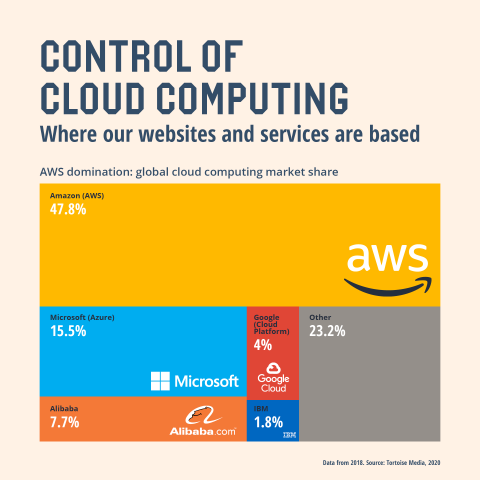
Brought to the market, yet not produced for sale
Rather than regarding data as a resource we should understand it as human experience and social relations that are ‘datafied’ and thus transformed into a commodity, which then can be sold. This does not happen naturally, but requires a great deal of political intervention and violence and has grave consequences both for individuals and also for societies. We should turn to Karl Polanyi to guide our thinking through the process of commodification and its consequences. In his classic The Great Transformation he describes the historical violence necessary to ensure that land, labour and money are transformed into commodities and to create the market society, an entirely separate and ‘self-regulating’ economic system, directed and controlled by market mechanisms. This economic logic, however, would soon come to colonise and dominate the social logic.
The fundamental difference between ordinary commodities (such as oil or wheat) and land, labour and money is that labour and money are what Polanyi calls fictitious, as they are the essential basis of human life. Treating them as if they were ordinary commodities undermines the very preconditions to commodity production and is the cause of three interrelated crises – the disintegration of communities and the increasing strain on care work, the depletion of nature, and the financialisation of the economy, with its recurrent destruction of livelihoods worldwide.
These developments would not have been possible without colonial processes of appropriation, possession, enslavement, and extraction. These processes are the foundation of the commodification of labour, land and money in Europe, and the creation of the market society and its subsequent expansion. The violent expropriation of land in the Americas is the precursor to the privatisation of the commons. Without chattel slavery, the racialisation and the literal commodification of millions of Black people, the commodification of labour is unthinkable. Enslaved work on plantations, plunder, and the emerging financial institutions intimately bound to slavery were key in providing the capital for industrialisation and the processes Polanyi describes.
How did commodification work in Europe? Let’s take Polanyi’s description of labour. He argues that labour is essentially another name for an activity that cannot be separated from human life itself. In order to commodify it, commonly held land had to be privatised, its peasant population violently dispossessed, early and local forms of welfare provision abolished, and men, women and children compelled to migrate to work in the emerging factories in urban centres. Only when robbed of their means of subsistence and production, only when violently forced to do, would people sell their labour in an institutionalised, national market in exchange for meagre wages. Labour was finally commodified.
Technological innovation, paid with the capital that came from the colonies, needed this form of organising labour in order to function. Care work in this system – cleaning, feeding, caring for the elderly and bringing up children – becomes an activity appropriated by capital, that is about reproducing the workforce rather than about sustaining and nurturing human life.
Since then, the market logic expanded both globally and into all areas of society. As Polanyi wrote: ‘A market economy can only exist in a market society’ Although our communication with friends or family, sharing our intimate thoughts and experiences, or our bodily functions, simply what we do in our everyday lives, is not intended to produce data, under digital capitalism it has become a commodity, transformed through extraction, abstraction and aggregation. This data can be sold and played back to us in the form of targeted advertisements.
The three interrelated crises of labour, land, and money come together in the process of the commodification of data, in what we commonly understand as digitalisation. It exacerbates rather than alleviates the depletion of nature, through the extraction of manifold materials. It is built with exploited labour, while entrenching the surveillance of workers and heightening their precariousness. And it makes the financialisation of the economy possible, which in turn finances it.
The great transformation, the market society in the twenty-first century, intends to capture human life itself and to commodify it all the way down. This essay is about the history of this commodification, its relation to the ecological crisis, and ways out of it.
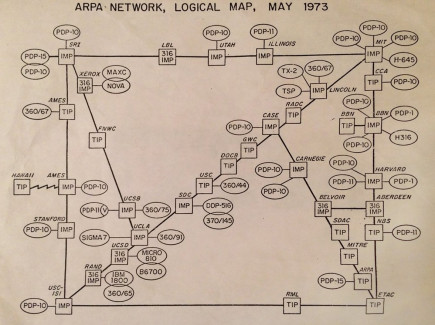
ARPANET, Public domain, via Wikimedia Commons
The making of data and its commodification
Digitalisation has a much longer history than is generally understood. The first computers – operated by women – were used to manage the huge volume of data that came from censuses at the turn of the twentieth century. Governments wanted to know about their citizens and the environment in order to govern them. Citizens, whose data was collected, were transformed and abstracted by bureaucrats into a ‘population’, with particular attributes that could be managed and administered. Likewise, militaries – now very decisive in shaping technologies essential for capturing data – wanted to predict the weather for war-purposes or for increasing the output of the industrialising agricultural sector.
In order to understand the commodification of data, it is vital to understand the history of information and communications technologies (ICTs). The internet, and most other technologies – from microprocessors, to the global positioning system (GPS), and touchscreens that enable our smartphones and make them ‘smart’ – came about through state investment and research from military-industrial complex of the US (and to a lesser extent the UK). The predecessor of the internet, the ARPANET, was envisioned to cement US hegemony and anticipate social upheaval, abroad and at home, which drew fierce opposition from the anti-war movement.
Efforts to create similar networks in the former Soviet Union or in Chile show that that there were alternatives to this development but that these networks were intended and used for central or democratic planning. With the onset of neoliberal policies from the 1980s to the 1990s, these technologies were commercialised, along with many public provisions and infrastructures, which peaked during the Clinton administration with the privatisation and commercialisation of the internet. The mantra of self-regulation meant companies could shape early internet policies to their liking. While state surveillance continued, companies were given free rein to shape the internet in the decades to come.
This non-regulatory approach prevailed until the 2010s when policymakers in North America and especially Europe, confronted with the powerful Big Tech companies and threats to their democracies, decided to step in to curb the major excesses.
Since the 1970s the financial industry developed in tandem with the information and communications industry. Digitalisation makes financialisation possible, providing a wide array of applications in exchange for venture capital. During the 1990s, for example, unprecedented volumes of venture capital were pumped into internet companies that promised business success. The dot-com crash in the early 2000s scuppered those dreams, but those based on advertising remained sturdy. Their models were based on collecting data that was supposed to make advertisements more relevant to (i.e. targeted at) users so they would spend more.
Thus, data collection was encoded in the very heart of the internet. In addition to state surveillance, private, for-profit surveillance was born, enabling the generation and digital enclosure of user activity into data. While the public is (rightly) highly critical of state surveillance, for-profit surveillance often evades such scrutiny, despite the ongoing cooperation between Big Tech and the military-industrial complex. Users’ increased engagement in their own surveillance is sought by every means possible, including strategies of gamification and addiction. As Blayne Haggart, digital policy scholar at the Canadian Brock University expressed it: ‘We have constructed a data-driven economy and society, in which the list of what can be turned into data and commodified – heartbeats, conversations, our expressed preferences – is limited only by our imaginations’.
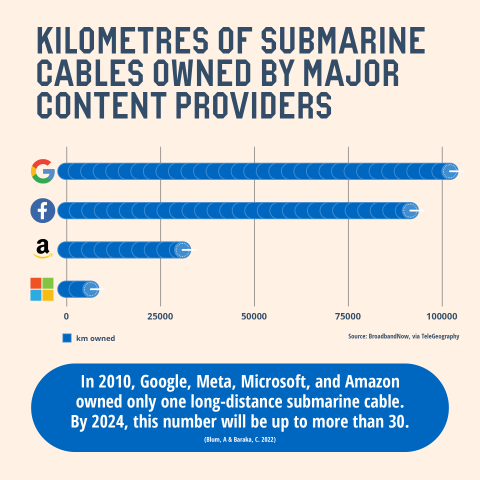
Palimpsests of infrastructure
In popular perception technological innovations and computational advances are a story of progressing dematerialisation – a story that enables the belief in digitalisation as ecological salvation. Technologies such as ‘the cloud’ made its ubiquity, its disconnection from its physical environment, a key selling point. Invisibility is a central feature of large-scale infrastructural systems – they are not supposed to be seen. Unearthing these stories will help us better understand how the commodification of data is possible, the ecological cost of data, and how these entrench extractivist, colonial relations.
Looking back at the period when telegraph connections started to link empires and their colonies, particularly through submarine cables, the material nature of communication networks became visible. While the unevenness of this global infrastructure still persists, the changing actors involved in financing the cables which are laid on the ocean floor also show the discontinuities of those wielding the power over global communication and its infrastructure. A hundred and twenty years ago, they were financed by empires, which imagined this would lead to a more efficient oversight and a more immediate command over their colonies and used colonial resources to build them.
An important advantage for British cable companies to control the market throughout the nineteenth century was their ability to insulate underwater cables through their access to the rubber-like gutta percha gum – natural latex – from colonies in the Malay Peninsula. Malays shared their indigenous knowledge of their environment, and this specific tree sap and its properties, with British colonial officers, which in turn became indispensable to the very beginnings of internet history. Its extraction soon became an ecological disaster. The first transatlantic cable, laid in 1857 between western Ireland and Newfoundland, was isolated with 250 tons of gutta percha, while a single felled tree yielded on average 312 grams of this material. When the British imposed a ban on the tree felling in 1883 it had already become extinct in many regions of today’s Malaysia. In the early twentieth century roughly 200,000 nautical miles (370,000 km) of cables criss-crossed the ocean floors, made up of the sap of an estimated 88 million trees.
Nowadays, former colonised countries and peoples are treated first and foremost as resources that can be tapped into rather than connecting them in their own right. Many fibre-optic submarine cables still follow routes established during colonial times. Increasingly the global tech giants finance, build and control new cables. In 2010, Amazon, Google, Meta, and Microsoft owned only one long-distance submarine cable. By 2024, there will be more than 30. This number includes projects such as Google’s Equiano cable connecting the entire West African coast or Meta’s 2Africa cable which circumvents the whole continent and branches off to the Gulf States, Pakistan and India, providing 3 billion people with as yet unparalleled capacity. Building their own cables gives Big Tech companies unprecedented technical and operational control – what data traffic is going where at what speed – and privileged access to the data and the attention of 1.4 billion potential internet users.
Meta and Google can afford the huge capital investments needed for laying these cables even without having to sell the bandwidth since the potential revenues of a new user base are deemed a sufficient return on investment. Nanjira Sambuli, a digital rights advocate based in Nairobi, remarks: ‘What’s mostly interesting in techno-politics is the “rush to connect the unconnected” and to retain them on a certain platform […] because it’s all about the data. How much data can I get about people, so I can sell ads, to create predictions to keep them hooked to what I offer’.
(Data) extractivism
The colonial nature of the digital economy becomes most visible in the old and new arenas of extractivism all around the globe. Extractivism comes in many forms – the manufacture of an exponentially growing volume of electronic and digital (consumer) devices relies not only on the exploitation of rare earth elements, other metals and human labour, but also the fossil-fuelled logistics of their transport. Further, their production and discharge generate waste, pollution, and toxicity.
Mining is often the deadliest arena for human and environmental rights defenders, often from indigenous communities. Global Witness reports that 1,733 of these defenders have been killed in the past ten years, with many more assassinations going unreported, as they seek to defend their lands from exploitation. Both the ‘green’ and the digital transition are increasing the extractive nature of the economy.
The devil’s metal
Much of the public attention regarding crucial metals for the digital economy has rightly been preoccupied with lithium mining in Bolivia, child and bonded labour in ‘artisanal mining’ for cobalt in the Democratic Republic of Congo, or geo-political conflicts surrounding rare earths. Tin is usually associated with cans rather than computers, but half of the world’s supplies are currently consumed by the electronics industry; and 30% is mined on the ‘tin islands’ of Bangka and Belitung of the coast of Sumatra, where unregulated mining turns rich rainforest ecosystems into toxic wastelands. Since the Dutch colonised the islands in the 1870s, the colonial administration sought to intensify and industrialise the pre-existing mining practices. Today’s low-tech, labour-intensive and dangerous mining has destroyed the coastal ecosystem, which provided a livelihood for local fishers, created stagnant pools of water which are breeding grounds for dengue and malaria, and proved deadly for miners.
Small chips, big toxics
Even after resource extraction, high-tech manufacturing contaminates and poisons its workers and their communities. Microchip production, for example, which has been offshored from California and New York to cheaper, more leniently regulated, globalised sites on ‘Silicon Island’ (Taiwan) or in ‘Silicon Paddy’ (China), involves intensive chemical inputs in order to use extracted ores. In 2002, to assemble one microchip one required 630 times the mass of the final product as production input, and up to 300 processing steps. These require large amounts of electricity, water and chemicals. Taiwan Semiconductor Manufacturing Company (TSMC), for example, is set to consume 7.2% of Taiwan’s electricity, and, amidst droughts caused by the climate crisis TSMC’s facilities consume roughly 63 billion litres of water each year.
In Endicott, New York, thousands of litres of carcinogenic solvents such as trichloroethylene (TCE) and perchloroethylene (PCE) ended up spilling into the ground, poisoning the groundwater and leading to increased rates of cancer and birth defects. During court proceedings, led by over a 1,000 of Endicott’s residents, IBM had to disclose the contents of a ‘Corporate Mortality File’, where it had tracked demographic data and the cause of death for 33,730 former employees. The data shows increased rates of respiratory, intestinal and breast cancer as far back as 1969. IBM tried to pump out the contaminated groundwater but it took 24 years and an order from the New York State Department of Environmental Conservation for the company to test the air quality and install mitigation systems in homes and public buildings. The pollution in Endicott is by no means unique. The Santa Clara Valley, more commonly known as Silicon Valley, has 23 locations catalogued as ‘Superfund’ sites – contaminated with hazardous substances – the most of any county in US. Successful clean-up is by no means certain. Many more places face similar issues all over the world.
Cooling servers, heating water and the climate
Access to water plays a decisive role not only in the production of semiconductors, but also in the geographical allocation of huge server farms, insatiable in their hunger for power and water to ensure their operation and constant cooling. Companies often secure favourable deals with communal or state administrations to satisfy their thirst for water for decades. The effects become increasingly visible under drought-induced water stress. For example, the NSA Data Center in Utah (one of the driest US states), at the time of its construction the third biggest assembly of servers in the world, was estimated to use about 6.5 million litres of water per day, depriving local communities and habitats. The NSA initially even refused to disclose this data, citing ‘matters of national security’. Contestation regarding the use of water has been unsuccessful as the city of Bluffdale had granted the NSA water at discounted rates for years to come.
The ‘ephemeral’ cloud is often placed in rural areas such as Utah or in the hills of Guizhou, and ‘cold’ countries like Finland, Iceland, Ireland or Sweden. Here, imperial imagination and corporate advertisement presents such locations as remote, ‘natural’, which obscure their environmental impacts as well as the political intervention that facilitated their construction. As usual, the abstracted and dematerialised image of the cloud hides the opposite.
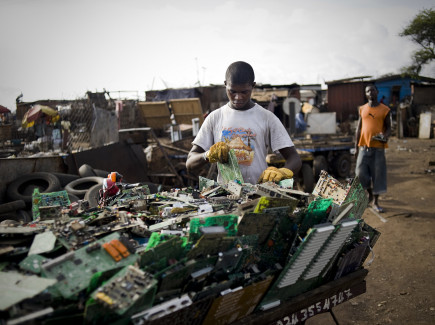
The Basel, Rotterdam and Stockholm Conventions/Flickr/(CC BY-NC-SA 2.0)
Disposable land, disposable people
Ultimately, electronic and digital devices, especially given their short lifespan, end up in the waste stream. Every year, the world discharges almost 50 million tonnes of e-waste. The overwhelming majority from the Global North ends up being exported to the ‘Majority World’, from North America and Europe to Nigeria or Ghana, from Japan to China, from Singapore to India. Most of the waste ends up in landfills, where heavy metals such as lead, mercury, cadmium, and other toxins leak into the ground and contaminate the groundwater and the food chain. Recycling and scavenging at these sites take place in precarious conditions and through crude and highly toxic methods, including smashing, open burning, and bathing electronics in acids, to collect small scraps of precious materials that can be sold. Exposure to toxic fumes is hazardous to the workers, often children, inhibiting development of the brain, nervous system and reproductive system. Many do not live beyond their twenties succumbing to their injuries, untreated wounds, respiratory diseases and cancer.
Zygmunt Bauman says that this form of toxic colonialism is characterised by disposable land and disposable people. It extends into the virtual world. Digital workers in the Philippines or India have to deal with pornographic, extremely violent or abusive content for social media giants. Reviewing videos of suicides, beheadings, massacres or sexual abuse of children causes severe trauma and other psychological harms, to the point where the workers themselves may attempt suicide. Unlike US-based moderators, workers in the Majority World do not get adequate psychological support, nor are they compensated after successful court cases in the US. Legal provisions often exempt Big Tech firms from many responsibilities for their employees, leaving the ‘othered’ global reserve army of labour in these countries struggling and making it clear to them that they are interchangeable and disposable.

Data extraction
It is only when we look at (digital) capitalism through a colonial lens that we are able to understand these processes of extraction and dispossession and the contemporary frontier of capitalist expansion. In the drive to open up new markets, generate new growth and tap into ever more ‘outsides’, capitalism turned ‘inwards’. Digital companies seeking to maximise profits have penetrated into ever more layers of human life itself enclosing and colonising previously non-commodified, private times and space.
Returning to Polanyi, this transformation seems only logical. If, with the commodification of land, labour and money, the nascent market economy could only exist in a market society, the commodification of data also requires its own disrupting and violent social transformation towards a ‘datafied society’. This transformation expresses itself in the many forms we have discussed.
Most importantly, however, social relations are no longer just embedded in an economic system, ‘they become the economic system, [...] human life is converted into the raw material for capital via data.’ Human experience and social relations are reduced to a production input and transformed so that they generate ever more data, which can be extracted, abstracted, aggregated and sold.
This is what Big Tech ultimately aims for – turning everything into data which ultimately generates a profit. Even if the violence of data collection itself is not as overt and crass as it was under historical colonialism, the mass of captured and commodified data, particularly through its automated, algorithmic processing, has profound effects in entrenching the current forms of racialised, gendered, and class-based oppression. It is all justified through the ideology of ‘knowing’ the world through the ‘objectivity’ of data.
The double movement – emancipatory data governance and de-commodification
No large-scale transformation or newly emerging social and economic order go uncontested. Polanyi describes a double movement: societies did not simply await the long marketisation of labour, land and money. Colonised peoples resisted colonial violence. The commodification of labour, land and money was followed by a countermovement of institutions and rules that protected society from the effects of unbridled marketisation. Many of these regulations, such as workers’ protection or welfare states, are in turn being challenged with the commodification of data and the transformation of society through data colonialism. Likewise, communities at today’s frontlines daily resist the corporations that seek to destroy their environments and turn them into sacrifice zones. Policymakers and digital rights activists around the world are continually fighting back against the power of Big Tech. Winning digital futures that are social, ecological, and just means confronting the commodification of data, but also the crises triggered by the commodification of labour, land, and money.
How could we find forms to govern data and its material infrastructure more democratically? One popular legal answer is the strengthen the right to privacy as, for example, in the European Union with General Data Protection Regulation (GDPR), or ban some of the data collection and targeted advertisements as under the Digital Markets and Digital Services Acts.
Simply regarding data commodification as a problem which pits individuals against corporations is not truly emancipating. Salomé Viljoen, a Michigan Law School professor, proposes reconceptualising data governance democratically so that it accounts for the insights generated at the level of populations, because, even if there were meaningful ways to withdraw individual consent from corporate or state data extraction, insights about that individual could still be inferred from aggregated data collected from people who were categorised as belonging to the same demographic group.
Acknowledging these data relations and understanding data governance in such a way opens a means to recast data as a common good or public utility. Data should be collected and used only in instances that are democratically agreed in advance and also that benefit citizens. It would allow for building counter-power and drastically reduce data extraction. This would allow for data ownership via public trusts or common ownership, forms that are emerging from the bottom-up. Existing data and data that is being collected by private entrepreneurs should be transferred to the public domain and institutions, similar to the expiry of intellectual property rights, before the latter are phased out entirely. Such data trusts acting on behalf of data subjects could, when existing in plurality, already ensure our empowerment vis-à-vis powerful corporations under the current system.
Approaches to the treatment of data as a common good that involves citizens’ contribution, access, use and ultimately empowerment are being successfully implemented in Barcelona, where city officials stress the need for transparency, accountability, and trust – and could be scaled (supra-)nationally through common property, public institutions that are subjected to scientific oversight and democratic accountability and that act independently from law enforcement or military institutions. These pushes for different regulative legislation and the creation of community structures for the participation of data governance needs to be complemented by ‘nowtopias’, niches where a desirable future already is being implemented, such as subversive ‘digital commoning’ projects or through the ‘contentious politics of data activism’.
The issue with the digital economy does not lie exclusively in the ability of certain very powerful companies to extract data for their profit, but rather in the colonial and extractive logic on which capitalism rests. Therefore, the response from any radically transformative countermovement must be broader, more comprehensive, and challenging to the power relations inherent in the digital economy and capitalism in general, while also representing the plurality and heterogeneity of all reality.
It will require struggles in many different areas. Platform workers all over the world are already expressing resistance through strikes, seeking and building solidarity and working class power, through unions, but also a continuum of strategies. From these countermovements, new models of ownership in the digital economy such as cooperative platforms are emerging. Rather than just supporting this flourishing of local, small-scale cooperatives, legislators should seek to socialise existing platforms. The latter also includes the (infrastructure of the) internet, which has to be geared towards serving as a and for the public good rather than having an ad-funded backbone.
While these proposals would not put an immediate end to the underlying phenomenon of the commodification of data, they would put us on a trajectory towards de-commodification. This de-commodification has to alongside the reduction of material throughput of the (digital) economy, a re-orientation towards sufficiency rather than efficiency. Degrowth proposals aptly identify the impossibility of decoupling resource intensity (and carbon emissions) from economic growth and the need for securing global well-being. There is a need for binding targets for reducing resource extraction. Indigenous and local communities should have a real say in consultations about extractive projects affecting them.
Advocates for the de-commodification of data should seek alliances with and learn from environmental and climate justice groups who are at the forefront of often local struggles against extractivist projects, and for a post-extractivist model of development that contest the colonial logic, which the digital economy requires and which is devouring environments all around the world, in order to arrive at caring futures in which it is possible to sustain global ecosystems.




